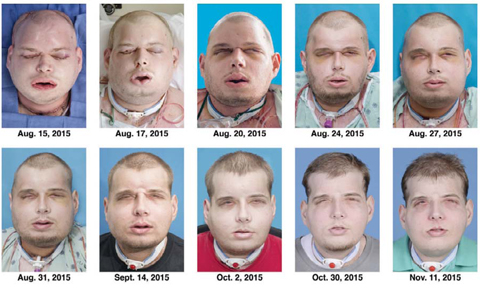 NEW YORK: This combination of Aug 15, 2015 to Nov 11, 2015 photos provided by the New York University Langone Medical Center shows the recuperation of Patrick Hardison after his facial transplant surgery.—AP photos
NEW YORK: This combination of Aug 15, 2015 to Nov 11, 2015 photos provided by the New York University Langone Medical Center shows the recuperation of Patrick Hardison after his facial transplant surgery.—AP photosNEW YORK: A volunteer firefighter badly burned in a 2001 blaze has received the most extensive face transplant ever, covering his skull and much of his neck, a New York hospital announced yesterday. The surgery took place in August at the NYU Langone Medical Center. The patient, 41-year-old Patrick Hardison, is still undergoing physical therapy at the hospital but plans to return home to Senatobia, Mississippi, in time for Thanksgiving.
The surgery has paved the way for him to regain normal vision, and in an interview last week he said that will let him accomplish a major goal: "I'll start driving again." More than two dozen face transplants have been performed worldwide since the first one in France in 2005. Dr Eduardo Rodriguez, who led the surgical team that did Hardison's transplant and recently wrote a review of the field, said Hardison's is by far the most extensive performed successfully in terms of the amount of tissue transferred.
The transplant extends from the top of the head, over Hardison's skull and down to the collarbones in front; in back, it reaches far enough down that only a tiny patch of Hardison's original hair remains - its color matched by the dark blond hair growing on his new scalp. The transplant includes both ears. The surgery began Aug. 14 and lasted 26 hours. It left no scars on Hardison's new face because the seam of the transplanted tissue runs down the back of his skull.
Skin grafts
The donor was 26-year-old New York artist and competitive bicyclist David P Rodebaugh. He had died of injuries from a biking accident on a Brooklyn street. Hardison was burned Sept 5, 2001, in Senatobia in northwestern Mississippi. A 27-year-old father of three at the time who'd served for seven years as a volunteer firefighter, he entered a burning house to search for a woman. The roof collapsed, giving him third-degree burns on his head, neck and upper torso.
He spent about two months at a Memphis, Tennessee, burn center. Doctors used a layer of skin from his legs to cover his wounded head, but he had lost his ears, lips, most of his nose and virtually all of his eyelid tissue. Since he could not blink, doctors used skin grafts to reinforce what remained of his eyelids and sewed them nearly shut to protect his eyes. That left him with only pinhole vision. "I was almost totally blind," he recalled. "I could see just a little bit."
His face was "one huge scar," Rodriguez said. Hardison still went to baseball games and did other things outside, although people stared. He playfully told curious children that he had fought a bear. Still, he said, life was hard. He endured 71 surgeries. Eventually a church friend of his wrote to Rodriguez, who had performed a 2012 face transplant at the University of Maryland Medical Center. The doctor said he would try to help, and in August 2014 Hardison was placed on a waiting list.










